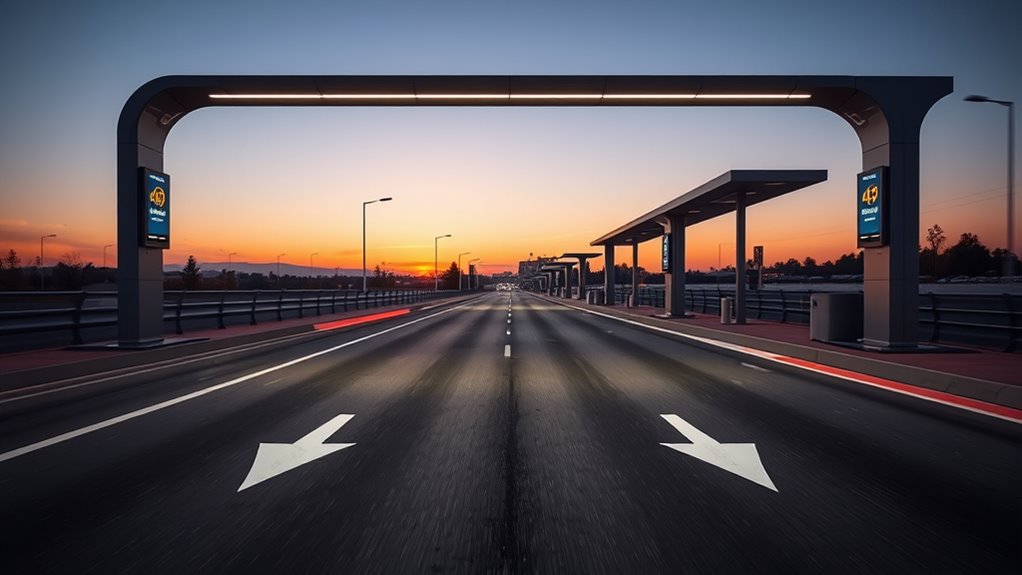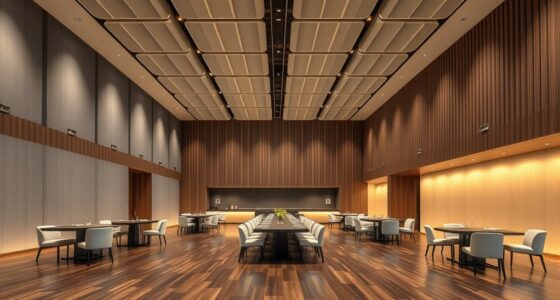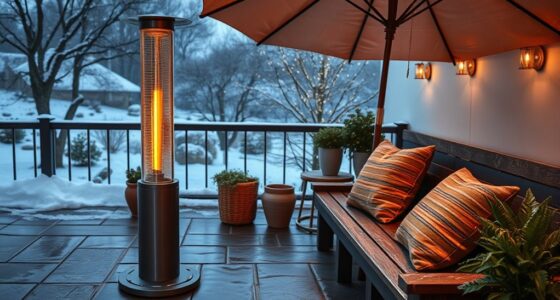To design a drive-thru lane for speed, focus on optimizing site layout with multiple wide lanes, clear signage, and proper lighting. Streamline traffic flow by using digital menus, contactless payments, and lane segregation for different vehicle types. Guarantee safety and accessibility with ample space and well-marked lanes. Regularly monitor traffic patterns and gather feedback to make data-driven improvements. Keep these tips in mind, and you’ll discover more ways to boost efficiency.
Key Takeaways
- Implement multiple, parallel lanes to increase throughput and reduce wait times during peak hours.
- Design wide, clearly marked lanes with smooth curves to facilitate quick vehicle movement and minimize congestion.
- Use high-contrast signage and effective lighting for visibility, ensuring drivers can easily follow lanes and instructions.
- Incorporate efficient payment and ordering technology, such as digital menu boards and contactless payment options.
- Optimize lane placement and signage to streamline traffic flow, minimize bottlenecks, and enhance overall speed.
Assessing Site Layout and Space Optimization

When designing a drive-thru lane, evaluating the site layout is crucial to guarantee smooth traffic flow and maximize space efficiency. You need to analyze the available land to determine the best placement for the lane, building, and parking areas. Consider the entrance and exit points to minimize congestion and avoid bottlenecks. Confirm the lane’s width and length accommodate expected vehicle volumes without causing backups. Also, think about the location of signage, landscaping, and lighting to enhance visibility and safety. Properly spacing the drive-thru lane from other property features helps prevent interference with pedestrian zones and parking. By carefully assessing these elements, you’ll create a layout that promotes efficient traffic movement while making optimal use of the space. Integrating innovative materials can further improve durability and aesthetic appeal in the design.
Designing Multiple Lane Configurations
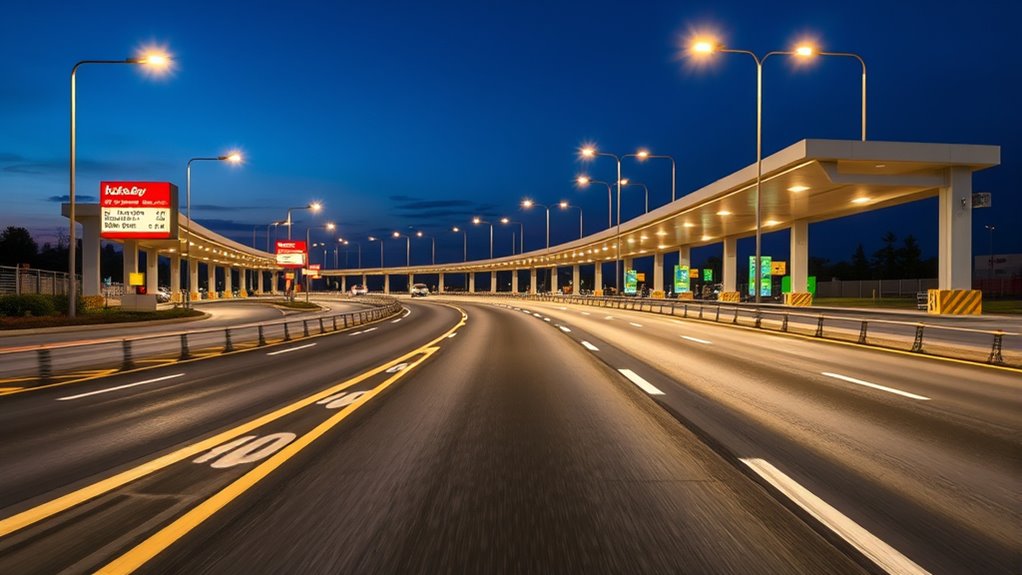
Designing multiple lane configurations allows you to efficiently handle higher vehicle volumes and reduce wait times. By providing additional lanes, you distribute traffic more evenly, preventing congestion during peak hours. Consider various layout options based on your site’s space and customer flow. For example, a dual-lane setup can accommodate more vehicles while maintaining smooth entry and exit. Here’s a quick comparison:
| Configuration Type | Pros | Ideal For |
|---|---|---|
| Parallel Lanes | Faster throughput | High-volume locations |
| Tandem Lanes | Space-efficient, organized | Limited space areas |
| Split Lanes | Better queuing management | Complex site layouts |
Choosing the right setup guarantees quicker service, improved safety, and better customer experience. Additionally, selecting an appropriate lane configuration can also help optimize traffic flow and reduce delays during busy periods.
Implementing Clear Signage and Wayfinding
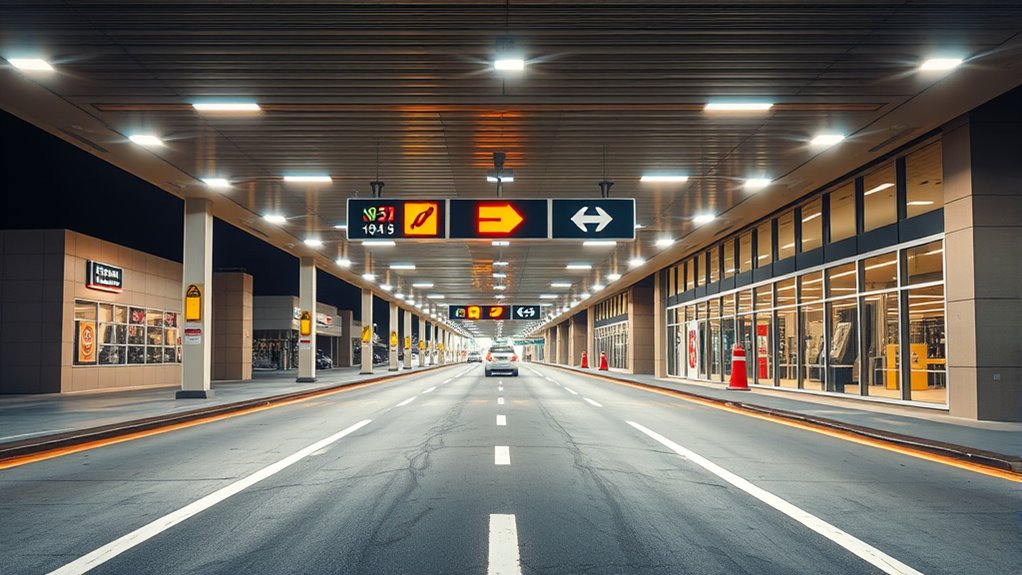
Have you considered how clear signage and effective wayfinding can transform your drive-thru experience? Well-placed signs guide customers smoothly from entrance to pickup, reducing confusion and delays. Use large, legible fonts and bright colors for visibility, especially from a distance. Arrow signs can direct traffic flow clearly, preventing bottlenecks. Incorporate clear lane markings and signage indicating where to stop, order, and pay. Consistent signage across all points avoids ambiguity and keeps drivers confident in their route. Additionally, strategic lighting ensures signs are visible at night or in bad weather. Regularly update signs to reflect operational changes or promotions. By prioritizing clear signage and wayfinding, you’ll create a seamless, efficient drive-thru that speeds up service and improves customer satisfaction. Incorporating good lighting enhances overall visibility and safety, especially in low-light conditions.
Streamlining Payment and Ordering Processes
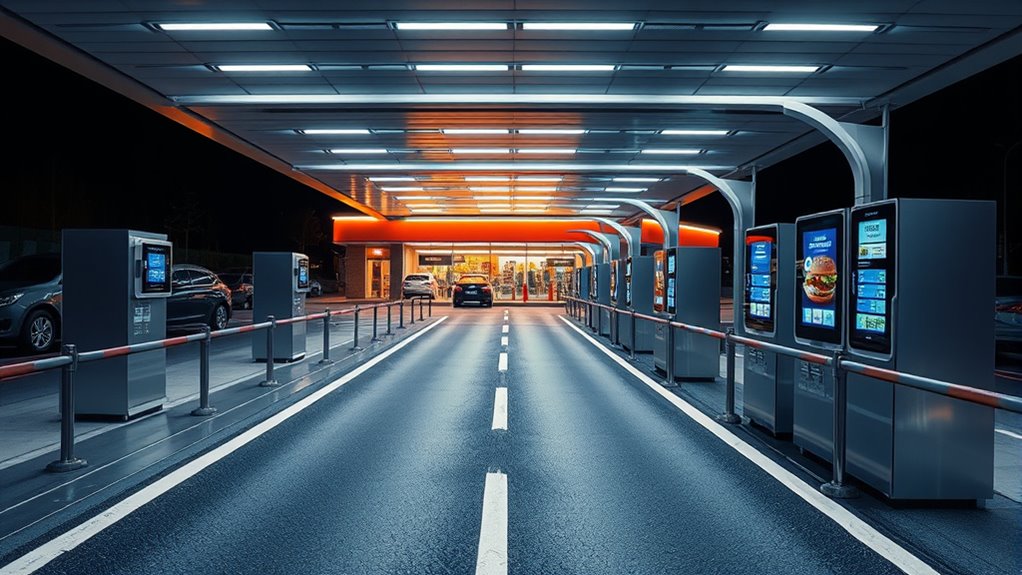
Streamlining payment and ordering processes is essential to reducing wait times and enhancing the overall drive-thru experience. You should design a clear, intuitive ordering system that allows customers to quickly select their items without confusion. Place menu boards at ideal heights and distances to ensure visibility from various angles. Simplify the menu to highlight popular choices, minimizing decision time. Encourage the use of multiple payment options, including contactless and mobile payments, to speed up transactions. Position payment windows conveniently, so customers can pay without unnecessary delays. Train staff to process payments efficiently and handle common issues swiftly. Implementing tuning techniques can also optimize vehicle performance, leading to smoother acceleration and deceleration which enhances the overall flow. By making these adjustments, you help create a smoother flow, reducing congestion and increasing customer satisfaction. Ultimately, a streamlined process benefits both your operation and your customers.
Incorporating Technology for Efficiency
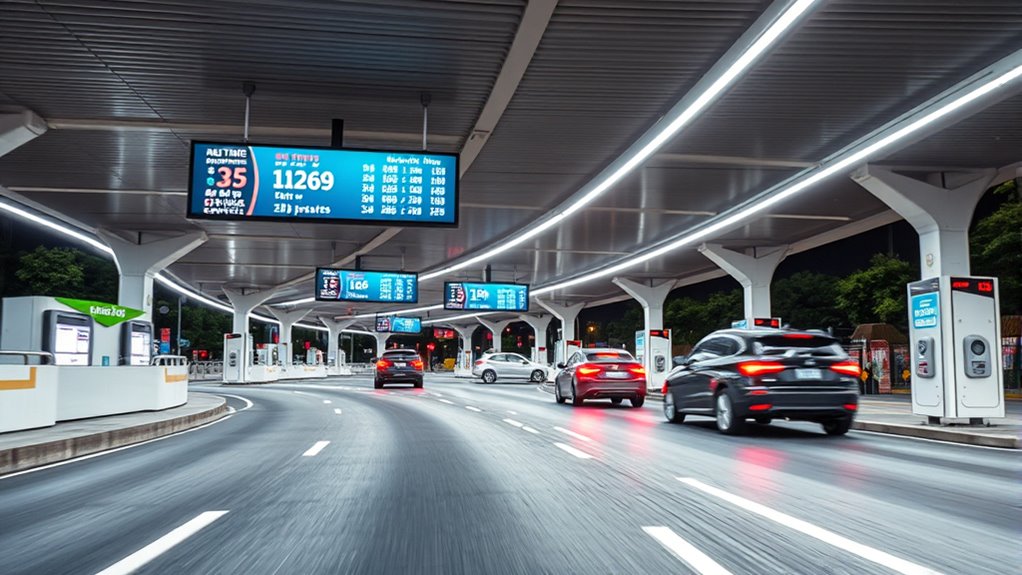
Incorporating technology into your drive-thru can markedly boost efficiency and reduce wait times. Implementing digital menu boards allows you to quickly update specials and manage traffic flow, helping customers decide faster. Using mobile ordering apps enables guests to place orders in advance, minimizing lines and congestion. Automated payment systems, like contactless card readers or QR code payments, speed up transactions and eliminate cash handling delays. Integrating license plate recognition can streamline repeat visits, automatically pulling up customer profiles. Additionally, real-time data analytics help you monitor peak hours and adjust staffing or lane configurations accordingly. By understanding market volatility and how it impacts precious metals, you can make more informed decisions about your investments. These technological upgrades work together to create a smoother, faster experience, ensuring customers get through your drive-thru more efficiently while freeing up resources and reducing overall wait times.
Ensuring Safety and Accessibility Standards
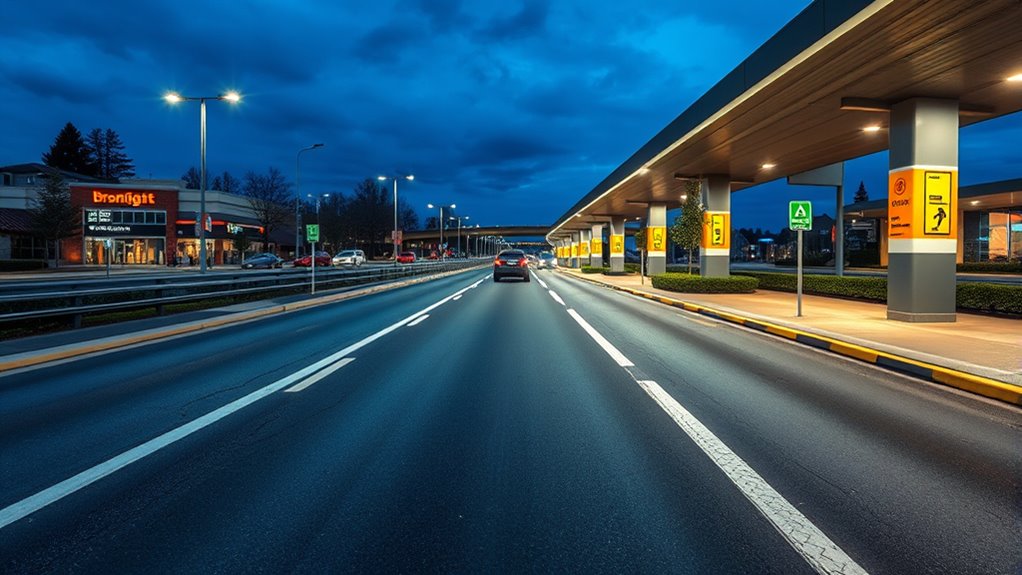
You need to guarantee that signage is clearly visible and properly placed so drivers can easily follow directions. Maintaining adequate lane width is essential for safe vehicle movement and accommodating all users. By focusing on these points, you create a drive-thru that’s both safe and accessible for everyone. Additionally, considering environmental considerations, such as proper site selection and fire safety regulations, can help promote sustainable and responsible design practices.
Clear Signage Placement
To guarantee safety and accessibility in drive-thru lane design, placing clear signage is essential. You should position signs where drivers can easily see them from a distance, giving enough time to respond. Use large, bold fonts and simple graphics to enhance readability. Place directional signs at decision points to guide vehicles smoothly through the lane. Ensure signage is well-lit and reflective for visibility at night or in poor weather conditions. Keep signs consistent in style and color to avoid confusion. Avoid clutter by limiting the number of signs and removing outdated or unnecessary information. Proper placement reduces sudden stops or lane changes, minimizing accidents and delays. Clear signage not only improves safety but also enhances the overall efficiency of the drive-thru experience. Incorporating hot roller signage can also help inform customers about available styling options to improve their experience.
Adequate Lane Width
Ensuring the drive-thru lane has adequate width is crucial for safety and accessibility. A properly sized lane allows vehicles to maneuver smoothly without risking side-swipes or congestion. The standard width ranges from 10 to 12 feet, providing enough space for drivers and passengers to feel comfortable. If your lane is too narrow, it increases the risk of accidents and makes it difficult for larger vehicles to pass. Consider the following to optimize lane width:
| Vehicle Type | Ideal Lane Width | Additional Space Needed |
|---|---|---|
| Sedans | 10 ft | Extra 1 ft for safety |
| SUVs & Vans | 11-12 ft | Extra 1-2 ft for clearance |
| Delivery Trucks | 12 ft | Maintain consistent width |
Adjust lane width based on your location and expected traffic to ensure safety and accessibility. Proper installation of safety features can further enhance the safety of your drive-thru lane.
Managing Traffic Flow and Queue Lengths
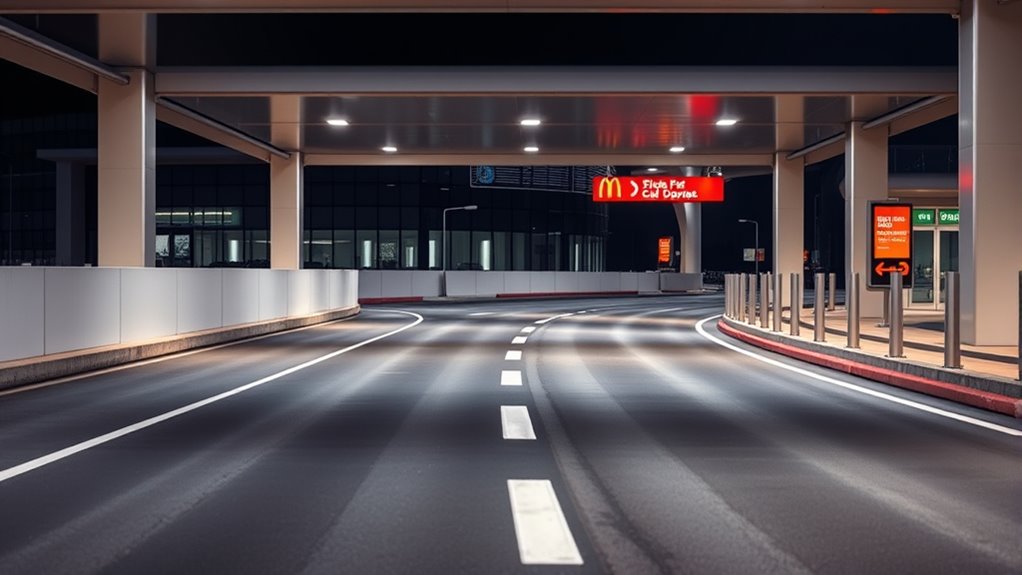
Effectively managing traffic flow and queue lengths is essential for minimizing wait times and preventing congestion in drive-thru lanes. To do this, monitor peak hours and adjust staffing or lane availability accordingly. Use clear signage and lane markings to guide vehicles smoothly through the process, reducing confusion and delays. Implementing designated lanes for different vehicle types, like cars and trucks, can also improve flow efficiency. Keep an eye on queue lengths; if lines get too long, consider opening additional lanes or redirecting traffic to nearby areas. Regularly evaluate peak times and adjust your operations to ensure vehicles move steadily without bottlenecks. Incorporating high contrast ratios in signage and lighting can improve visibility during all hours, aiding in smoother traffic management. By maintaining a steady flow, you enhance customer experience and maximize throughput, ultimately boosting your drive-thru’s productivity.
Utilizing Data and Feedback for Continuous Improvement
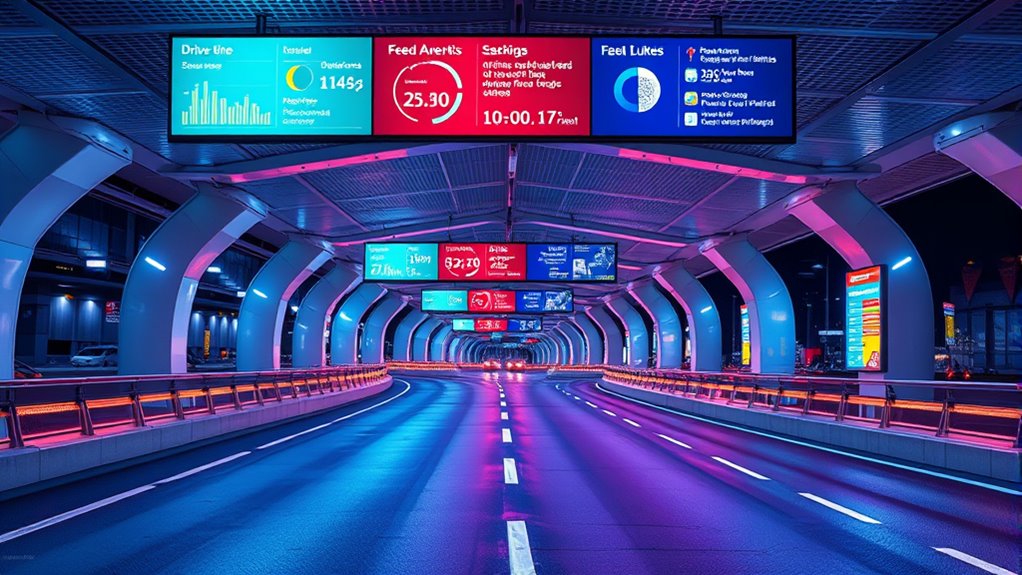
You can improve your drive-thru lane by regularly analyzing traffic patterns to identify bottlenecks. Using this data, you make targeted, iterative changes to optimize flow. Continuous feedback helps guarantee your adjustments lead to lasting efficiency gains. Monitoring traffic flow and adjusting accordingly can also prevent delays during peak hours.
Analyzing Traffic Patterns
How can you optimize drive-thru efficiency without understanding traffic patterns? You can’t. Analyzing traffic patterns helps you identify peak hours, bottlenecks, and flow issues. Use data from sensors, cameras, or transaction logs to observe vehicle movements and wait times. Look for recurring congestion points and patterns in customer flow. This information reveals when and where delays happen, so you can adjust lane configurations or signage accordingly. Feedback from staff and customers also offers valuable insights into real-world issues affecting throughput. By continuously monitoring and analyzing this data, you gain a clear picture of how your drive-thru operates. This understanding allows you to make informed decisions, optimize lane design, and improve overall speed and customer satisfaction.
Implementing Iterative Changes
Implementing iterative changes is essential for continuous improvement in drive-thru efficiency, and it relies heavily on the ongoing use of data and customer feedback. You should regularly analyze performance metrics, such as wait times and order accuracy, to identify areas for refinement. Customer feedback offers insights into their experience and expectations, guiding meaningful adjustments. By testing small modifications, measuring results, and making further tweaks, you create a cycle of ongoing improvement. To illustrate, consider this table:
| Change Implemented | Measured Result | Next Step |
|---|---|---|
| Lane reconfiguration | Reduced wait time by 15% | Fine-tune signage |
| New ordering system | Increased order accuracy | Optimize staff training |
| Signage clarity | Better traffic flow | Add visual cues |
This approach ensures your drive-thru evolves efficiently over time.
Training Staff for Rapid and Safe Service
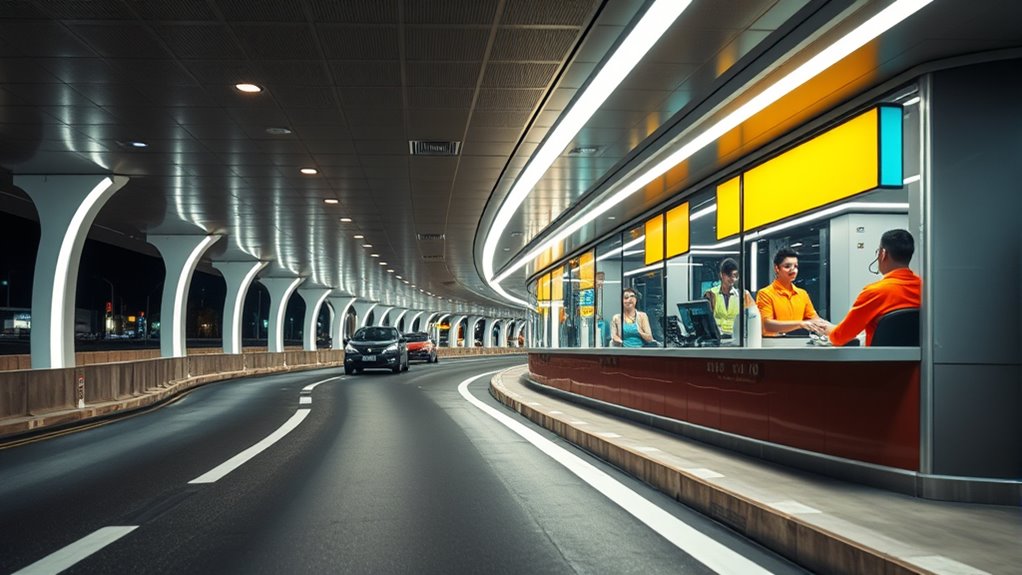
Effective staff training is vital to guarantee rapid and safe service in a drive-thru lane. You need to ensure your team understands the importance of efficiency and safety protocols. Start by teaching them how to quickly take orders accurately, minimizing delays. Emphasize the importance of clear communication and active listening. Train staff to recognize and respond promptly to customer needs and potential safety hazards. Practice smooth, confident movements to reduce errors and speed up service. Regularly review procedures and provide feedback to improve performance. Cross-train team members so they can step into different roles as needed, preventing bottlenecks. Well-trained staff create a seamless experience that keeps lines moving and customers satisfied while maintaining safety standards.
Frequently Asked Questions
How Does Weather Impact Drive-Thru Lane Performance?
Weather considerably impacts drive-thru lane performance. Rain, snow, or fog can slow down traffic as drivers proceed more cautiously, leading to longer wait times. Wet or icy surfaces may cause accidents or delays, and extreme heat can make customers less patient. You should consider weather patterns when designing your drive-thru, incorporating features like covered lanes or heated areas to maintain efficiency and keep customers comfortable regardless of the weather conditions.
What Are the Environmental Considerations for Drive-Thru Lane Design?
They say “look before you leap,” and that’s true for environmental considerations in drive-thru lane design. You need to account for weather, runoff, and eco-impact. Use permeable materials to reduce flooding, guarantee proper drainage, and minimize pollution runoff. Incorporate shade and shelter to protect customers and staff from the elements, all while preserving natural surroundings. These steps help create a sustainable, efficient drive-thru experience that respects the environment.
How Can Drive-Thru Lanes Accommodate Electric Vehicle Charging?
You can accommodate electric vehicle charging in drive-thru lanes by installing dedicated charging stations that are easily accessible and integrated into the lane design. Make certain there’s enough space for vehicles to park safely while charging, and use clear signage to guide EV drivers. Incorporate charging infrastructure seamlessly into the existing layout, allowing for quick stops without disrupting the flow of other vehicles, consequently enhancing convenience and sustainability.
What Legal Regulations Influence Drive-Thru Lane Construction?
Think of legal regulations as the blueprint for your drive-thru lane’s foundation. You need to navigate zoning laws, Americans with Disabilities Act requirements, and local building codes that shape how you construct and operate your lane. These rules guarantee safety, accessibility, and compliance, guiding you through permits, signage, and layout standards. Ignoring them risks costly delays or legal issues, so stay informed and work closely with local authorities to build a compliant, efficient drive-thru.
How Do Cultural Differences Affect Drive-Thru Lane Preferences?
Cultural differences shape how you prefer drive-thru lanes, influencing factors like lane width, signage, and service speed. You might favor wider lanes for comfort or clear signs for ease of navigation, depending on local customs. In some cultures, quick service is key, so you expect streamlined processes. Recognizing these preferences helps you design drive-thru lanes that meet diverse needs, enhancing customer satisfaction and efficiency.
Conclusion
By optimizing your drive-thru lane design, you can boost efficiency and customer satisfaction. Did you know that well-designed lanes can reduce wait times by up to 30%? Implementing clear signage, technology, and staff training makes a real difference. Continuously gather feedback and adapt your layout to meet evolving needs. With these strategies, you’ll provide a faster, safer experience that keeps customers coming back and your business thriving.
